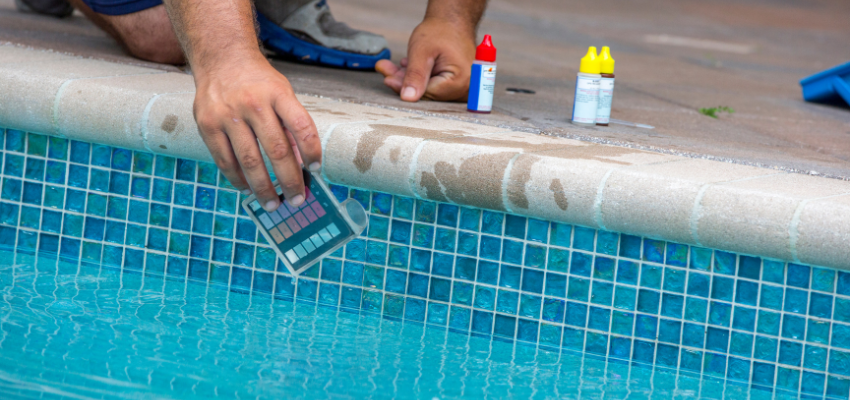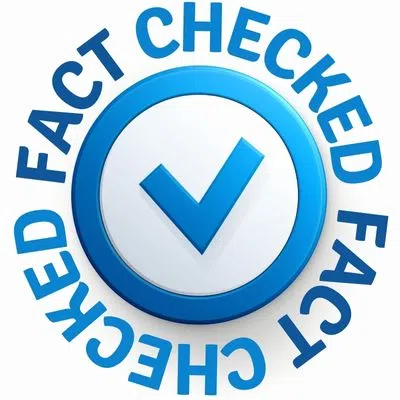Why And When Should You Acid Wash Your Swimming Pool?

Published November 28, 2022
There are a variety of tasks that a swimming pool owner must do to maintain the cleanliness and safety of their pool. Skimming, vacuuming, and adding chlorine are a few examples of such tasks.
Among these, acid washing is perhaps the most overlooked routine.
While it’s understandable since it’s not something you’d do every week, one must still keep in mind that it’s an incredibly important part of pool maintenance. But what does acid wash mean, anyway?
What Does It Mean To Acid Wash Pool?
As the name implies, acid wash involves acids and washing. To be more specific, it’s when you mix hydrochloric acid with a lot of water, then spray the solution onto the pool’s surface.
Since it involves acid, it’s supposed to be an incredibly delicate routine.
After all, if you use too much acid, you might dissolve several layers of the surface. And if you use only a little, it may not lead to any improvement. But what should be the improvement? you may ask.
Why Acid Wash Pool?
The idea behind a pool acid wash is to use the hydrochloric acid’s corrosive properties to get rid of tough stains and other build-ups. However, there are other benefits to an acid wash.
Below are some examples of the improvements an acid wash can bring to your pool’s surface:
Eliminate Tough Stains
The first improvement would, of course, be the reduced amount of stains.
An acid wash doesn’t eliminate stains in general, but the particular tough stains that you cannot get rid of with vacuuming or regular brushing. These include stains from chlorine, dirt, and minerals.
Remove Sticky Algae
Algae is normally something you can take care of with some rough brushing, but that’s not always the case. If a particular patch of algae remains long enough, it can become incredibly sticky.
An acid wash is often the only solution to the problem in those cases.
Improve Pool’s Appearance
Certain pool owners may acid wash pool even if there aren’t any stains or algae.
Their main goal, in those cases, is to simply improve the pool’s appearance. And it’s likely because the outer layer of the surface has already faded or discolored. An acid wash can make it smoother.
So, as you can see, an acid wash is an essential part of pool maintenance, which may come as a surprise since it’s not discussed as often. Well, that’s because it’s not something you often do.
How Often Should You Acid Wash Your Pool?
A general rule of thumb is to acid wash a pool every five years. That’s why it’s not something pool owners talk about as often, at least when compared to other pool maintenance routines.
After all, brushing should be done twice per week, while adding chlorine must be done once a week.
Nevertheless, that doesn’t make acid washing any less important. But keep in mind that unlike brushing or skimming, there’s such a thing called ‘too often’ as far as acid washing is concerned.
Since an acid wash involves harsh chemicals, doing it more frequently than necessary can damage the pool’s surface. It’s also worth noting that certain pools don’t require an acid wash.
For one, you mustn’t acid wash above-ground and vinyl-lined pools.
Otherwise, you can damage the pool lining, negatively affecting its appearance and effectiveness. Acid washing, in general, is just a delicate process and must be handled with care.
With that in mind, the following section should guide you through the process.
A Step-By-Step Guide To Acid Washing
What You Need
- Pool brush
- Drainage hose
- Spray nozzle
- Safety equipment (acid-resistant gloves, boots, and mask)
- Protected clothes (long-sleeved shirt and long pants)
- Muriatic acid
- Watering can
- Two (2) garden hoses
- Soda ash
- Water test kit
1. Drain And Clean The Swimming Pool
Since muriatic acid is harsh, you’d want to use as little of it as possible.
If the pool’s surfaces have patches of algae and a bunch of dirt, you may be forced to use a lot of the acid. Hence, before you start, you must drain the pool, then clean it thoroughly.
Your main goal for this step is to get rid of the debris to reduce the amount of acid needed to eliminate tough stains. Just use whatever tool you have at your disposal with that goal in mind.
Examples of tools you can use include a pool brush, a hose, and a spray nozzle.
2. Replace The Hydrostatic Relief Valves
If you’re aware of the standard procedures to drain a pool, you likely know that it requires you to remove the hydrostatic relief valves. They prevent the acid from seeping into the groundwater.
Once the hydrostatic relief valves are gone, the pool water may flow out.
Since the ‘pool water’ you must deal with likely contains muriatic acid, you don’t want that to happen. So, before you proceed with the acid wash, you must reinstall or replace the hydrostatic relief valves.
3. Prepare The Solution
Usually, the acid mixture consists of equal parts of muriatic acid and water. However, you can play with the ratio, mostly by reducing the amount of acid, if you think the mixture will be too harsh.
The less acid you add, the gentler but less effective the mixture will be.
Place the mixture in your watering can.
4. Connect The Garden Hoses
Connect one end of the first garden hose to a spigot and put the other end to the pool. Don’t put a spray nozzle on this hose. Do the same with the other garden hose, but this time, put a nozzle.
Keep the water running on both.
5. Acid Wash Pool
Now, you can acid wash the pool. It’s mostly manual work since you have to move to the area you want to acid wash. Wet the surface with the hose without a nozzle before you pour the acid mixture.
Acid can damage dry surfaces, so wetting it first is a crucial step.
Upon pouring the mixture, use a brush to scrub the surface. Wait for around 30 to 60 seconds, depending on how dirty the surface is before you rinse it using the garden hose with a nozzle.
This is where it gets tricky since you have a hose on one hand and a watering can on the other. That’s why you need an extra person to hold the scrub and the hose with the nozzle spray.
Do this throughout the entire pool.
6. Neutralize The Acid Mixture
When acid washing, you mustn’t let the mixture linger on a surface for too long. That’s why as you work your way through the pool, you must add soda ash to the bowl where the acid mixture ends up.
You must continuously add soda ash to balance the pH level.
Two pounds of soda ash should be enough to neutralize one gallon of the acid mixture. You might have to read the manufacturer’s instructions and notes for both the soda ash and the muriatic acid.
7. Check The pH Level With A Test Kit

Naturally, you’d want to get rid of the wastewater from this project. However, to prevent environmental damage, it’s best to check the water’s pH level first using a water test kit.
You must keep the pH level as neutral as possible.
For your reference, a neutral pH level is 7. If it’s lower, that means it’s acidic, so add more soda ash.
8. Eliminate The Wastewater
Again, if you follow the standard procedures to drain a pool, you likely have used a submersible drain pump. To eliminate the wastewater, you must take the pump and set it up in the collection pool.
However, if you didn’t use a pump, simply collect the wastewater the way you usually do.
You may have to rinse the deep end of the pool where the acid mixture ends up one more time. And again, you must pump out the wastewater from that rinse and dispose of it accordingly.
At this point, you should now be able to refill the pool.
Safety Tips When You Acid Wash Pool
Since muriatic acid is extremely corrosive, you must handle it with care.
Below are some safety tips to help ensure safety throughout this project:
- Do not let the acid linger in your pool’s lining.
- Rinse the acid as soon as it’s already done its job.
- Move away all unnecessary objects in the pool, such as chairs and devices.
- Keep children and pets away. The fumes alone can be dangerous, which is why safety equipment is necessary. The children and pets will likely not have safety equipment.
- Don’t acid wash if it’s windy. You don’t want the fumes to blow into the neighborhood.
- Read and follow the manufacturer’s instructions in the muriatic acid packaging.
Though these safety tips should go a long way in helping you acid wash pool, the best tip would be to simply hire an agency to do the job for you. They should have more experience with this task.
How Much Does It Cost To Acid Wash A Pool?
The national average cost to acid wash pool is $0.06 per square foot. So, if your pool is 20 feet by 40 feet and is 6 feet deep, you’re looking at a total expense of $288, which is already quite cheap.
Of course, that may not be the exact price point you have to deal with when you actually attempt to acid wash the pool. Also, keep in mind that this price is when you hire an agency for the acid wash.
It’s a different story if you’re looking to acid wash by yourself.
The cost would generally depend on your tools. If you already have pretty much everything, then you’ll likely spend only a minimal amount. The main issue there is the labor for the acid wash.
Splitting it into several days is not advisable since you don’t want the acid to linger on your pool’s surface. Otherwise, it may damage the lining. So, you’ll mostly spend one day acid washing a pool.
(Related: What Is White Water Mold: Causes, Prevention, And Treatments)
Hire Boca’s Favorite Pool Builders
Excel Pool and Patio Solutions is your trustworthy provider of pool services in Boca Raton. We are experts in pool and patio remodeling and can handle your resurfacing needs as well. Our technicians are vetted and trained for your guaranteed satisfaction. Get to know us by browsing our website or reaching out to us with any questions.
Contact our team today to request a free estimate for pool construction, maintenance, repairs and more.

Fact Checked By Experts
This is original content and has been diligently fact checked by our internal team of experts. Discover more about the rigorous editorial standards we uphold for our website here.

About The Author
Lenard Arceo is an experienced writer and digital marketing expert. He loves to code and spending time outdoors. He has helped many reputable websites grow over the years.



